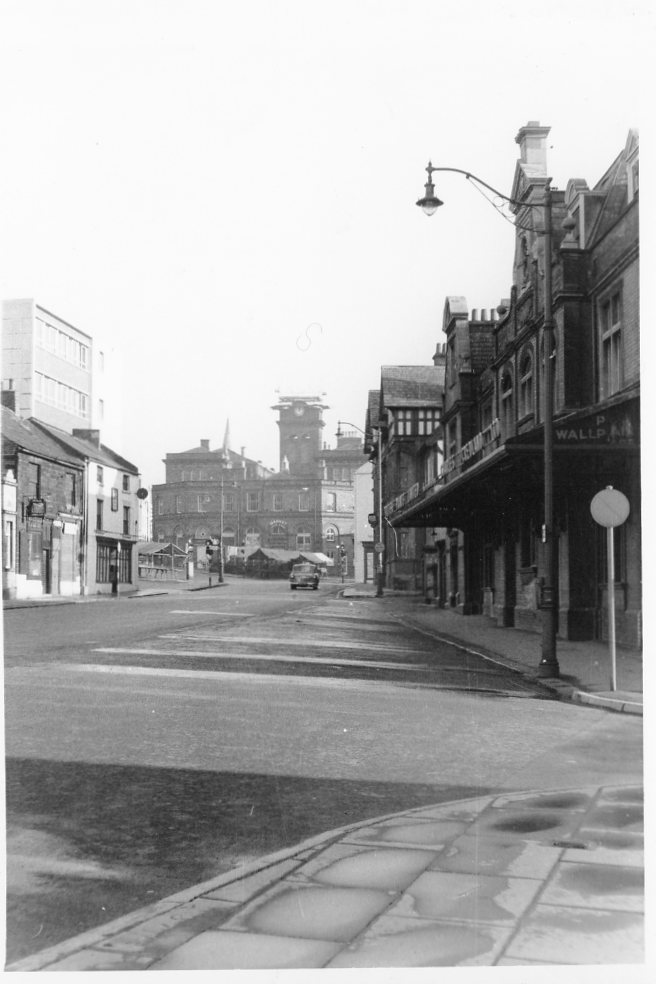Our county editor (Philip Riden) has been investigating a long-running mystery of who designed the now demolished Lancashire, Derbyshire & East Coast railway station at Chesterfield Market Place. In this blog we take a look at this work and reveal who we think was the architect.
The Lancashire, Derbyshire & East Coast Railway
The Lancashire, Derbyshire & East Coast Railway (LD&ECR) famously never reached either of its intended destinations and had an independent existence of barely ten years. It’s one of those oddities of railway history which has attracted antiquarian attention out of all proportion to its modest economic importance.
Nothing, however, seems to have been written about one aspect of its history: the identity of the architect of the stations on the line between its western terminus at Chesterfield ending at a junction with the Great North & Great Eastern Joint line near Lincoln.

The station design
The station at Chesterfield, which stood on the south side of West Bars at the west end of the town’s large Market Place, was in a class of its own: an imposing three-storey building, with a front range facing the street and two wings flanking the platforms behind, executed in red brick with stone dressings and slate roofs. It was in a vaguely Dutch baroque style. The upper floors served as the company’s offices. Chesterfield station was opened in March 1897
Reported in detail – but no architect mentioned
The opening event was reported in detail in local newspapers. The LD & ECR has also been the covered in some detail in around six different volumes. But neither the newspaper reports in the books mention an architect. There’s also some copies of the Market Place Station plans in Chesterfield Local Studies Library – but no architect’s name is on them.
Not the Portland Hotel’s architect
The Portland Hotel was next door to the LD & ECR station. Opened in 1899 it was designed by the Sheffield architect James Ragg Wigfull (1864–1936), who did other work for Stones brewery, mainly in the city. It remains open today. Wigfull was not, however, the railway company’s architect.
The station’s designer discovered – Cole Alfred Adams
The best clue so far found as to who designed both Chesterfield station and the semi-standard design used for the other stations on the line comes from an incidental aspect of the building of the railway, in the National Archives at Kew.
Because of the late date of its construction, the LD & ECR was subject to the Act requiring railway companies which demolished working-class housing for their line to build a corresponding number of new dwellings.
In Chesterfield the company’s line curved away to the east from the station at Chesterfield, through a heavily congested area of slum housing behind the buildings on Low Pavement on the south side of the Market Place. The architect for the rehousing scheme which the company had to execute was Cole Alfred Adams. He practised mainly in London and did not work (as far as is known) for any other railways.
Who was Cole Adams?
Adams was born at Sudbury in Suffolk, where he was baptised on 13 September 1844. He was the son of William Cole Adams, a wine and spirit merchant, who died young.
In 1851 Cole was noted in the census as one of six children in a household headed by his widowed mother, Eliza Jane Adams, aged 33. The household also included a governess and three servants.
Ten years later, aged 16, Cole was working as a clerk in London and lodging at 12 Clapham Road, Lambeth. By 1871 he had trained as an architect. The census of that year has him staying at Downton Lodge, the home of a retired Army officer and his family, in the Hampshire village of Hordle, near Lymington.
Cole Adams appears to have worked in Bournemouth for part of the 1870s, where he was in partnership with Henry Peter Horner. He then appears in a number of towns and latterly in London and is associated with a number of building designs. He married, aged 44, in 1889 and appears to have done quite well for himself, but died in February 1909, aged 64. At this time the family were living at 13 Glazbury Road in West Kensington.

Adam’s work for The LD & ECR
Adam’s work for the LD&ECR fell into the last phase of his career, when he had an office in Victoria and a substantial home in West London.
In April 1896 the directors of the railway agreed to pay him professional fees of £578 in connection with their Chesterfield rehousing scheme. This was calculated as 5 per cent on the contract price, which was £11,560.
Although firm evidence has yet to be found (we’re still looking for more evidence), it seems almost certain that, if Adams undertook the rather mundane work of preparing drawings for working-class cottages for the LD & ECR, he must also have been commissioned to design the stations (and possibly other buildings) on the line.

How did Adams come to work for the LD & ECR?
How did a London architect with a practice which seems to have been mainly confined to the Home Counties come to be engaged by a small independent railway company in the East Midlands?
The answer appears to be a fairly distant family connection. The LD &ECR’s solicitor in its early years was Dixon Henry Davies, originally from London. In 1891 he was living at a house named Longlands, on Slack Lane in Brampton. Davies was in practice in partnership with C.S. Busby.
Davies later married, at St John’s parish church in Clapham, Alice Constance Westmacott, the daughter of J.S. Westmacott. It was a connection through the Westmacott family that made Cole Adams and Alice Davies cousins. This in turn appears to have led Mrs Davies’s husband to suggest to the directors of the Lancashire, Derbyshire & East Coast Railway that Adams should be engaged to design the stations on the new line.
Handsome buildings at a cost
The result of Adam’s engagement with the LED & ECR may have been a group of handsome buildings, especially the one at Chesterfield. However, the decision to build on the scale the company did may have been another (admittedly probably small) contribution to the financial problems which dogged the company from the start. These ultimately and led to its early demise as an independent concern.
Sadly, because of the demolition of Market Place station in Chesterfield in 1973 and the disappearance of most if not all the smaller stations, there is today little or nothing to see of Adams’s work for the company.
Work is still on-going on the Adams’ story, with a fuller account in preparation.
Attempts made to identify the architect of the Market Place railway station have been prompted by the awarding a of grant to Chesterfield and District Civic Society from the East Midlands Railway community fund. This is to fund a plaque to commemorate the Portland Hotel and the former adjacent railway station.
There’s more about the history of Chesterfield’s railway stations in our blog here.

Why do you feel it was a “sad loss” when this station building was demolished?
We think the loss of this building was sad as the design was interesting and its demolition left a gap in the townscape – which was actually acknowledged by Fielden and Mawson when they looked at the town centre during their 1976 appraisal, which led to a more conservation based approached to development.